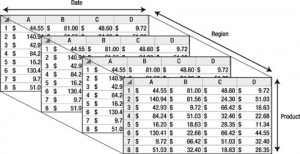Dimensions in Dynamics NAV 2013 – Part 2 (Deployment)
In Part 1, I described how dimension integration in Microsoft Dynamics NAV has been significantly improved with the NAV 2013 release. In this post, I would like to discuss how dimensions in NAV can best be deployed now that performance is no longer the primary constraint. Beyond the dimension itself and its relative importance for your business, you will need to consider three important numbers related to dimensions in Dynamics NAV: 2, 4 and 8.
In NAV, you are able to create an unlimited number of dimensions and use as many of those as you wish on any given transaction. As an example, a company may assign a department, cost center, customer group, item group, and project to a sales invoice line. The requirements for dimensionalization and the rules for combinations may all be maintained in setup tables that are either defined up front or as your company’s use of those dimensions evolves. A company intent enough on various measurements could see well over ten different dimensions in use. As the introduction of additional dimensions is considered, it is important to know how that information will ultimately be used and what additional burden on data entry is acceptable. This is where the numbers 2, 4 and 8 become more important.
2: There are two global dimensions
A global dimension is simply the name NAV assigns to the two most important dimensions. These are not only stored in the parent tables and referenced by their Dimension Set IDs, but they are also included on every posted entry. As such, you are able to filter and sort on these values from posted ledgers and documents.
4: There are four dimensions allowed in an Analysis View
An analysis view is the out-of-the-box business intelligence (BI) tool that NAV provides for slicing and dicing your dimensionalized data. With an analysis view, you are able to review the interplay between dimensions, drop the data to an Excel pivot table via a built-in-tool, or append an existing account schedule to use the included dimensions. You are able to have as many analysis views as you wish and can build them by any combination of up to four dimensions at a time. The limiting factor here is simply that any specific analysis view may only include four dimensions.
8: The eight dimensions deemed most important, via setup (also called shortcut dimensions)
On most document and journal lines, the first eight dimensions may be edited right on the line. Dimensions beyond these eight may still be entered, but require an extra click by the user to open a separate page.
I often recommend a brainstorming session to first identify the dimension candidates. Once the list is compiled, the importance of each of these should be ranked. The cutoffs may then be considered. As an example, if five potential dimensions are identified, the final one may require a little extra consideration as it would fall outside of the four-dimension limit in Analysis Views. It may ultimately still be deployed, but this is where the cutoffs are best considered. With the final list in hand, one additional consideration should be discussed: which of the dimensions are candidates to have their values defaulted into transactions. As an example, it is sometimes advantageous to have the customer numbers duplicated as a customer dimension. In these cases, the user should never need to manage the dimension; it should simply go along for the ride with the customer itself. There are a number of these and examples include customers (and/or groups), vendors/groups, salespeople (and/or territories, regions), items/groups, resources/groups, jobs, etc…
An upgrade is a good opportunity to introduce additional dimensions if you want history to also include those values. Alternatively, if you’re on NAV2013 and wish to deploy new dimensions and append history, the process should not be cost-prohibitive. We have scripted a few of these and the investment is not significant. Some additional options will be explored in the next entry: Part 3 (Extension).
Under the terms of this license, you are authorized to share and redistribute the content across various mediums, subject to adherence to the specified conditions: you must provide proper attribution to Stoneridge as the original creator in a manner that does not imply their endorsement of your use, the material is to be utilized solely for non-commercial purposes, and alterations, modifications, or derivative works based on the original material are strictly prohibited.
Responsibility rests with the licensee to ensure that their use of the material does not violate any other rights.

